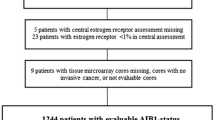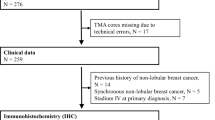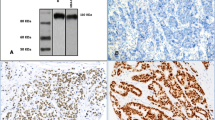Abstract
Purpose Amplified in breast cancer (AIB1 or SRC-3) is an estrogen receptor coregulatory protein that together with other co-activators like transcription intermediary factor 2 (TIF2) and nuclear receptor co-repressor (NCoR), is implicated in estrogen signaling pathway and estrogen regulated tumor progression. We investigated the prognostic significance of AIB1, TIF2 & NCoR protein expression breast tissue microarray (TMA), and studied the relationship of coregulatory proteins to prognostic biomarkers like estrogen (ER), progesterone (PR) & HER2/neu and between coregulatory proteins. Methods: AIBI, TIF2 & NCoR were studied by fluorescent immunohistochemical staining of a TMA with 670 breast cancer specimens, using AQUA software. Result: Using Cox univariate survival analyses, high AIB1 expression was associated with poor patient outcome (P = 0.002), while no association was noted for TIF2 (P = 0.376) & NCoR (P = 0.12). When subclassified by nodal or ER status, AIB1 was not prognostic in the node positive and ER positive subsets. However, in the ER negative and node negative subsets, high AIB1 expression was associated with poor patient outcome (P = 0.02 and P = 0.007 respectively). AIB1 retained its independent association with survival by multivariate analyses (P = 0.028). There was significant positive correlation between AIB1 and ER and PR status and with other cofators (TIF2 and NCoR) but not with HER2/neu status. Conclusion: High AIB1 expression was predictive of worse overall survival in our study, suggesting that AIB1 may be critical in breast carcinogenesis.






Similar content being viewed by others
References
Clarke R et al (1994) Hormonal carcinogenesis in breast cancer: cellular and molecular studies of malignant progression. Breast Cancer Res Treat 31(2–3):237–248. doi:10.1007/BF00666157
Ferguson AT, Davidson NE (1997) Regulation of estrogen receptor alpha function in breast cancer. Crit Rev Oncog 8(1):29–46
Lemieux P, Fuqua S (1996) The role of the estrogen receptor in tumor progression. J Steroid Biochem Mol Biol 56(1–6 Spec No):87–91
Anzick SL et al (1997) AIB1, a steroid receptor coactivator amplified in breast and ovarian cancer. Science 277(5328):965–968. doi:10.1126/science.277.5328.965
Hudelist G et al (2003) Expression of sex steroid receptors and their co-factors in normal and malignant breast tissue: AIB1 is a carcinoma-specific co-activator. Breast Cancer Res Treat 78(2):193–204. doi:10.1023/A:1022930710850
List HJ et al (2001) Expression of the nuclear coactivator AIB1 in normal and malignant breast tissue. Breast Cancer Res Treat 68(1):21–28. doi:10.1023/A:1017910924390
Font de Mora J, Brown M (2000) AIB1 is a conduit for kinase-mediated growth factor signaling to the estrogen receptor. Mol Cell Biol 20(14):5041–5047. doi:10.1128/MCB.20.14.5041-5047.2000
Osborne CK et al (2003) Role of the estrogen receptor coactivator AIB1 (SRC-3) and HER-2/neu in tamoxifen resistance in breast cancer. J Natl Cancer Inst 95(5):353–361
Osborne CK, Schiff R (2003) Growth factor receptor cross-talk with estrogen receptor as a mechanism for tamoxifen resistance in breast cancer. Breast 12(6):362–367. doi:10.1016/S0960-9776(03) 00137-1
Schiff R et al (2004) Cross-talk between estrogen receptor and growth factor pathways as a molecular target for overcoming endocrine resistance. Clin Cancer Res 10(1 Pt 2):331S–336S. doi:10.1158/1078-0432.CCR-031212
Cottone E et al (2001) Role of coactivators and corepressors in steroid and nuclear receptor signaling: potential markers of tumor growth and drug sensitivity. Int J Biol Markers 16(3):151–166
Cregger M, Berger AJ, Rimm DL (2006) Immunohistochemistry and quantitative analysis of protein expression. Arch Pathol Lab Med 130(7):1026–1030
Giltnane JM et al (2007) Quantitative measurement of epidermal growth factor receptor is a negative predictive factor for tamoxifen response in hormone receptor positive premenopausal breast cancer. J Clin Oncol 25(21):3007–3014. doi:10.1200/JCO.2006.08.9938
Camp RL et al (2003) Quantitative analysis of breast cancer tissue microarrays shows that both high and normal levels of HER2 expression are associated with poor outcome. Cancer Res 63(7):1445–1448
Camp RL, Dolled-Filhart M, Rimm DL (2004) X-tile: a new bio-informatics tool for biomarker assessment and outcome-based cut-point optimization. Clin Cancer Res 10(21):7252–7259. doi:10.1158/1078-0432.CCR-04-0713
Camp RL, Chung GG, Rimm DL (2002) Automated subcellular localization and quantification of protein expression in tissue microarrays. Nat Med 8(11):1323–1327. doi:10.1038/nm791
Murphy L et al (2003) New insights into estrogen receptor function in human breast cancer. Ann Med 35(8):614–631. doi:10.1080/07853890310014579
Murphy LC et al (2000) Altered expression of estrogen receptor coregulators during human breast tumorigenesis. Cancer Res 60(22):6266–6271
Bautista S et al (1998) In breast cancer, amplification of the steroid receptor coactivator gene AIB1 is correlated with estrogen and progesterone receptor positivity. Clin Cancer Res 4(12):2925–2929
Guan XY et al (1996) Hybrid selection of transcribed sequences from microdissected DNA: isolation of genes within amplified region at 20q11–q13.2 in breast cancer. Cancer Res 56(15):3446–3450
Kurebayashi J et al (2000) Expression levels of estrogen receptor-alpha, estrogen receptor-beta, coactivators, and corepressors in breast cancer. Clin Cancer Res 6(2):512–518
Bouras T, Southey MC, Venter DJ (2001) Overexpression of the steroid receptor coactivator AIB1 in breast cancer correlates with the absence of estrogen and progesterone receptors and positivity for p53 and HER2/neu. Cancer Res 61(3):903–907
Kirkegaard T et al (2007) Amplified in breast cancer 1 in human epidermal growth factor receptor - positive tumors of tamoxifen-treated breast cancer patients. Clin Cancer Res 13(5):1405–1411. doi:10.1158/1078-0432.CCR-06-1933
Girault I et al (2003) Expression analysis of estrogen receptor alpha coregulators in breast carcinoma: evidence that NCOR1 expression is predictive of the response to tamoxifen. Clin Cancer Res 9(4):1259–1266
Azorsa DO, Cunliffe HE, Meltzer PS (2001) Association of steroid receptor coactivator AIB1 with estrogen receptor-alpha in breast cancer cells. Breast Cancer Res Treat 70(2):89–101. doi:10.1023/A:1012972808558
Anzick SL et al (2003) Phenotypic alterations in breast cancer cells overexpressing the nuclear receptor co-activator AIB1. BMC Cancer 3:22. doi:10.1186/1471-2407-3-22
Iwase H et al (2003) Clinical significance of AIB1 expression in human breast cancer. Breast Cancer Res Treat 80(3):339–345. doi:10.1023/A:1024916126532
Carroll RS et al (2000) Expression of a subset of steroid receptor cofactors is associated with progesterone receptor expression in meningiomas. Clin Cancer Res 6(9):3570–3575
Reiter R, Wellstein A, Riegel AT (2001) An isoform of the coactivator AIB1 that increases hormone and growth factor sensitivity is overexpressed in breast cancer. J Biol Chem 276(43):39736–39741. doi:10.1074/jbc.M104744200
Henke RT et al (2004) Overexpression of the nuclear receptor coactivator AIB1 (SRC-3) during progression of pancreatic adenocarcinoma. Clin Cancer Res 10(18 Pt 1):6134–6142. doi:10.1158/1078-0432.CCR-04-0561
Xie D et al (2005) Correlation of AIB1 overexpression with advanced clinical stage of human colorectal carcinoma. Hum Pathol 36(7):777–783. doi:10.1016/j.humpath.2005.05.007
Osborne CK, Schiff R (2005) Estrogen-receptor biology: continuing progress and therapeutic implications. J Clin Oncol 23(8):1616–1622. doi:10.1200/JCO.2005.10.036
Acknowledgements
The authors would like to acknowledge Summar Siddiqui for assistance with the figures and Bonnie E. Gould Rothberg for statistical guidance.
Financial disclosure: Dr. Rimm is supported by grants from the NIH including NIH R33 CA 106709 and NIH R33 CA 110511.
Author information
Authors and Affiliations
Corresponding author
Rights and permissions
About this article
Cite this article
Harigopal, M., Heymann, J., Ghosh, S. et al. Estrogen receptor co-activator (AIB1) protein expression by automated quantitative analysis (AQUA) in a breast cancer tissue microarray and association with patient outcome. Breast Cancer Res Treat 115, 77–85 (2009). https://doi.org/10.1007/s10549-008-0063-9
Received:
Accepted:
Published:
Issue Date:
DOI: https://doi.org/10.1007/s10549-008-0063-9




